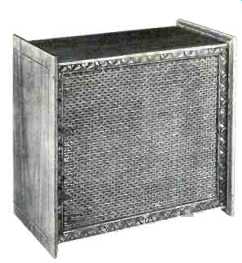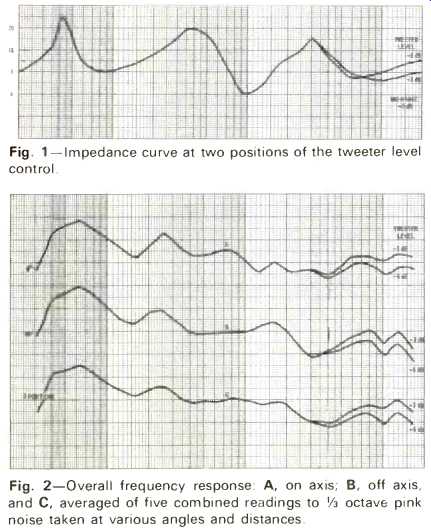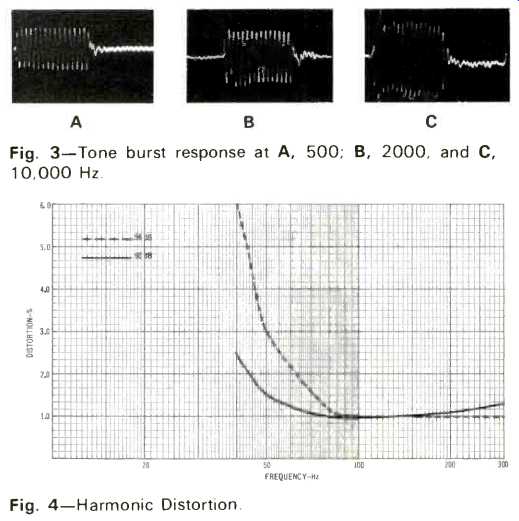
MANUFACTURER'S SPECIFICATIONS
Frequency Response: 25 to 20,000 Hz.
Min. Input Power: 15 watts, IHF per channel.
Max. Input Power: 60 watts, IHF per channel.
System Impedance: 8 ohms.
Speaker Components: 15 in. woofer, 5 in. acoustically isolated midrange, 1 in. omnidirectional mylar dome tweeter. Enclosure Type: Acoustic suspension.
Size: 24 in. x 22 3/4 in. x 13 5/8 in. (includes table tops).
Finish: Oiled walnut.
Weight: 72 lbs.
Price: $223.00.
The Wharfedale W70E is a high quality, moderately priced floor-standing speaker system, which uses the infinite baffle principle without being unduly large. According to British Industries Co., which distributes the Wharfedale line in this country, the W70E can be used either as a high-boy, by standing the speaker on its end, or as a low-boy, by placing it on its side.
Within the relatively small confines of this enclosure are housed a 15 in. woofer, a 5 in. midrange unit and a 1 in. domed treble radiator. The woofer incorporates a heavy cast chassis, a large 10 1/2 lb. magnet assembly, and a long-throw rubber suspension. The midrange speaker is housed in a separate cylindrical sub-enclosure, thus preventing modulation of the midrange by the back pressure of the woofer. Crossover to the midrange unit is specified at 500 Hz. The 1 in. tweeter comes in at 5000 Hz, overlapping the midrange and carrying on to the limits of audibility.
Screw terminals for the amplifier output leads, as well as midrange and high frequency level controls, are provided on the back panel in a recessed area. The attractively finished walnut cabinet has a removable grille, and the entire system weighs in at 72 lbs.
Performance

Fig. 1--Impedance curve at two positions of the tweeter level control.
Fig. 2--OveralI frequency response: A, on axis; B, off axis, and C, averaged of five combined readings to 1/3 octave pink noise taken at various angles and distances.

Fig. 3-Tone burst response at A, 500; B, 2000, and C, 10,000 Hz.
Fig. 4-Harmonic Distortion.
For our tests, we set the midrange and the tweeter controls to minus 3 and minus 6 dB, respectively, from their wide open positions. These settings were chosen after listening to a variety of program material. The relative amount of high frequency energy that one uses depends on the acoustical environment and the listener's preference in concert hall seating location.
Figure 2 shows the speaker system's frequency response on axis, off axis, and averaged. Note the smooth transition when using either 3 or 6 dB tweeter cut.
The system impedance varied quite a bit across the frequency spectrum, but that really shouldn't present any problems. Sensitivity is somewhat above average, being 87 dB for 1 watt input. From the distortion figures of Fig. 4 and the frequency response graphs, it is clear that the system can be considered good down to 40 Hz and usable down to 30 Hz.
The higher than average efficiency of the Wharfedale W70E permits some savings in amplifier power. A good 30 watt rms amp will drive this system very nicely. To sum up, this loudspeaker from British Industries is a well-made product which will fit into most decors and won't put a strain on amplifier or pocketbook.
-Alex Rosner
(Audio magazine, Mar. 1972)
Also see:
Wharfedale E-90 Loudspeaker System (Sept. 1981)
Wharfedale speakers (ad, Nov. 1977)
= = = =